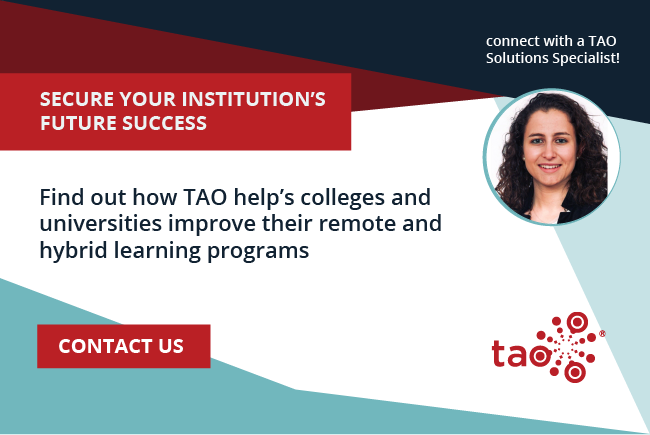Over the last year, universities and colleges across the board have seen a stark decline in enrollment. A recent report from Inside Higher Ed shows that enrollment declined by 4.5%, for undergraduate programs, and fell by 2.9% across all institution types in the spring of 2021, despite a slight uptick for graduate programs. In facing these enrollment challenges, higher education leaders have expressed concern about the sustainability of their institution’s current model in the future, with one study showing that only 39% of college presidents feel confident in this over the next 10 years.
In order to ensure their financial health, institutions are driving forward looking for new ways to evolve with today’s learners, increase enrollment and maintain a steady revenue stream into the future.
Just a few months ago, Barnes & Noble Education published a research study called COLLEGE 2030: Transforming the Student Experience, offering insight into how higher education institutions must adapt to remain sustainable. In this report, CEO and Chairman Michael Huseby, notes:
“The pandemic did not change the path for higher education, but it did change the speed at which we’re traveling on that path. Within the next 10 years, we will see a transformation of the student experience – from admissions through graduation – that will ultimately create a better, more inclusive and smarter world.” – Michael Huseby, CEO and Chairman of Barnes & Noble Education
Because the pandemic has required new avenues for learning, students and institutions have seen their ability to “be more nimble, flexible, and available in multiple modalities.” As students are the technology consumers in higher education, their expectations for flexible and sophisticated software will only continue to grow. In this post, we discuss ways that colleges and universities can combat enrollment challenges by using EdTech to diversify their revenue streams.
Diversify Revenue Streams
Harvard Business School professor Clay Christensen predicts that in the next 10 to 15 years, more than half of American Universities will close. This prediction is echoed by the sentiment of today’s students, where the Barnes and Noble Education College 2030 study reports that 44% of students say the value of college has declined due to the pandemic.
To stay competitive in Higher Ed, institutions must provide an engaging student experience that reaches today’s learners where they are and directly drives post-graduate success. This starts with digital transformation driven by technology.
As many students are questioning the worth of a traditional, four year degree, institutions need to rethink their offerings to provide flexible, non-traditional learning opportunities. In fact, many graduate programs are already seeing success in doing so, diversifying their revenue streams through:
- Hybrid/Blended Learning models
- Micro-degrees and stackable credentials
- Real-world training opportunities
Offer Blended / Online Models
Today’s students are juggling more than just their education. Between balancing their courses, jobs, personal life and obligations, they have to be flexible — and are looking for education opportunities that meet that need. Hybrid learning is noted for its flexibility, blending both classroom and distance learning. Many institutions are adapting hybrid learning models to introduce “flipped classroom” or self-paced learning.
- Flipped classroom: Students watch recorded lessons as online homework and complete their assignments, labs, and tests in class, either in a virtual or onsite classroom. This allows for a higher degree of flexibility and personalization, as students can spend class time working through any gaps or misunderstandings around the content with the teacher acting as a guide.
- Self-paced: Students complete learning tasks at their own pace that’s customized to their personal levels of mastery.
Educators are able to use a mix of interoperable EdTech tools, like virtual conferencing software, LMS systems and online assessment to facilitate teaching and learning and to provide timely feedback.
[Learn more about our series on interoperability in EdTech or connect with one of our Solutions Specialists today!]
In fact, Harvey Mudd College in Claremont, CA has been experimenting with a flipped classroom model, where professors have been tracking the results of students compared to a traditional setting. Interestingly enough, they found that students were performing just as well in the flipped classroom, leading them to think of new opportunities for expanding their hybrid offerings.
Launch Micro Credentialing Programs
Micro-credentialing programs have seen a new surge in momentum as a result of the toll the pandemic has taken on the economy, leaving millions of people out of jobs or unable to afford a traditional degree.
“People are looking for shorter forms of learning during this time. They don’t know whether they have two months, three months,” says Anant Agarwal, CEO of edX, an online course provider for Harvard and MIT. “For them the ability to earn a micro credential within a few months and improve their potential to get hired as we come out of Covid becomes much more important.” – Anant Agarwal, edX CEO.
Another flexible model, microcredentials allow students to complete short skills-based, online programs that prepare them immediately for the work-force and can ultimately stack together to count towards an undergraduate or graduate degree.
For these programs to be successful, institutions must have organized, streamlined access to student data across various programs and technology platforms. And it has to be secure. In this context, implementing EdTech built on interoperability standards to enable seamless and safe data sharing is crucial for institutions to validate their micro credentialing programs.
Partner with Corporations to Provide Training Opportunities
Traditional higher education programs can be largely theoretical. However, today’s students are looking for hands-on learning that directly relates to their success in the job market. However, only 27% of recent graduates report having a good job upon graduation. At the same time, only a dismal 26% of working U.S. adults with college experience strongly agree their education is relevant to their work and day-to-day life, according to Forbes.
Co-op Programs
College and University co-op programs, short for cooperative education, allow students to alternate between semesters of studying and full-time work with a partnering organization. This allows students to help explore career paths and apply their learning in practical, real-world contexts to promote better learning outcomes.
At Northeastern University, flagshipped in Boston, MA, the co-op program is the cornerstone of the student learning experience and one of the key drivers for enrollment, as well as post graduate success. As students are meshing their work and school experience, institutions must have sophisticated assessment tools in place to allow students to demonstrate what they’ve gained and enable instructor insight into the process.
—
In today’s hybrid learning environment, the competition between institutions for enrollments and revenue is increasing like never before. As students’ needs are continuously evolving, it’s critical that the schools provide the sophisticated technology they expect, in particular when taking assessments online. Heading into the new school year, interoperable technology must be at the forefront when planning to support students across new modalities.
Want to learn more about how TAO can help you engage more students and set your institution’s future up for success? Contact us today to chat with a TAO Solutions Specialist!


